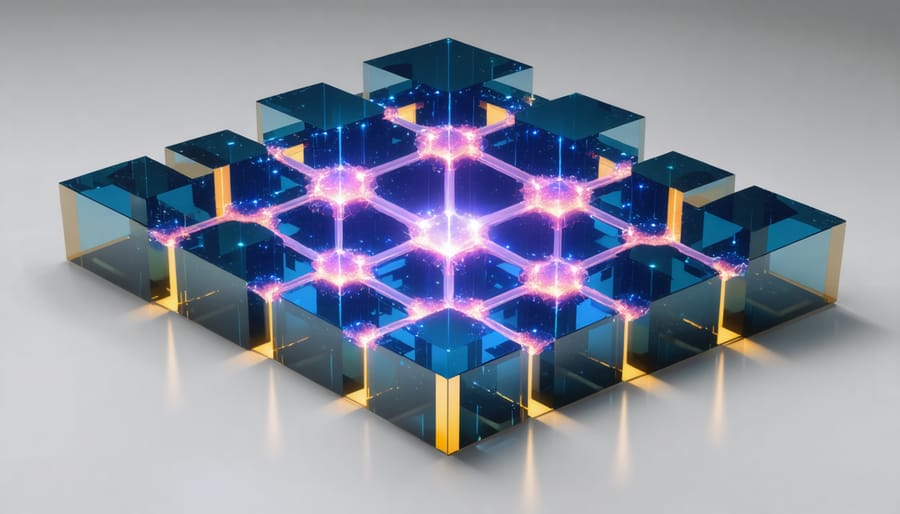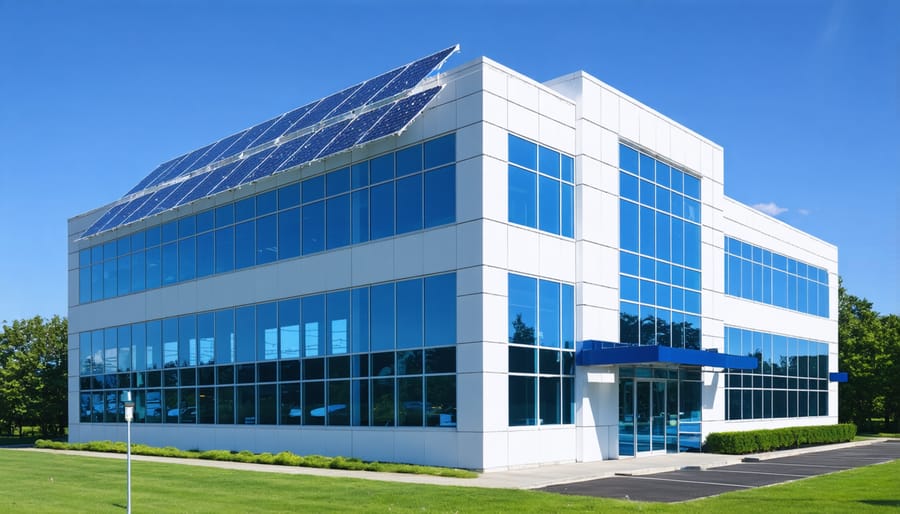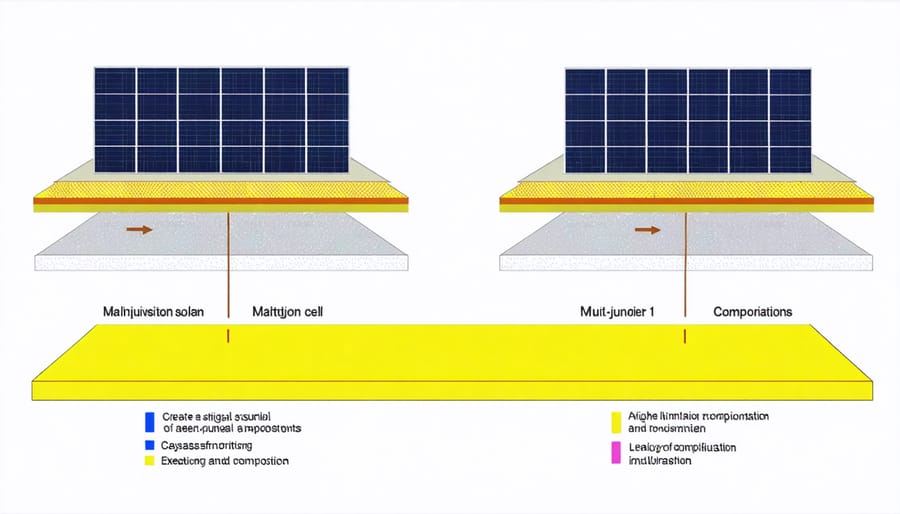These Breakthrough Solar Materials Will Transform Your Energy Future

The next decade of solar technology stands poised to revolutionize how we harness the sun’s power, with groundbreaking solar panel efficiency breakthroughs reshaping Europe’s energy landscape. Perovskite-silicon tandem cells are already achieving unprecedented 30% efficiency rates in laboratory settings, while transparent solar materials are transforming windows and building facades into power-generating surfaces. These innovations, coupled with emerging quantum dot technology and artificial intelligence-driven optimization systems, promise to slash installation costs by 60% while doubling energy capture capabilities by 2030.
European research institutions and manufacturers are leading this technological renaissance, developing adaptive solar solutions specifically engineered for the continent’s diverse climate conditions. From self-cleaning nanocoatings that maintain peak performance in Nordic winters to ultra-thin flexible panels that integrate seamlessly with historical architecture, these advancements are making solar power more accessible and efficient than ever before. As we stand on the cusp of this solar revolution, the convergence of materials science, artificial intelligence, and sustainable engineering is opening new possibilities for how we power our future.
Perovskite Solar Cells: The Next Generation Power Source

Why Perovskites Matter for European Solar
Perovskite technology represents a significant breakthrough for European solar markets, offering unique advantages that align with the continent’s sustainability goals and energy needs. Unlike traditional essential solar panel materials, perovskites can be manufactured at lower temperatures, reducing production costs and energy consumption.
For European homeowners and businesses, perovskite-based solar panels offer exceptional performance in diffuse light conditions – a crucial advantage given Northern Europe’s often cloudy climate. These materials demonstrate remarkable efficiency even during overcast days, extending useful generation hours and improving overall energy yield.
The adaptability of perovskites also presents exciting possibilities for building-integrated photovoltaics (BIPV) in European urban environments. Their thin-film nature and flexibility allow for integration into windows, facades, and curved surfaces, making them ideal for historic buildings and modern architecture alike.
European manufacturers are particularly well-positioned to leverage perovskite technology, thanks to the region’s strong research infrastructure and established manufacturing capabilities. Several EU-funded projects are already developing scalable production methods, promising to create local jobs while reducing dependence on imported solar technologies.
The technology also aligns perfectly with EU circular economy initiatives, as perovskite panels can be manufactured using more sustainable processes and materials that are easier to recycle compared to conventional silicon panels.
Commercial Viability Timeline
The journey from laboratory breakthrough to market-ready solar technology follows a predictable yet exciting timeline. Currently, perovskite solar cells are leading the innovation wave, with commercial deployment expected by 2025-2026. Major European manufacturers are already scaling up production facilities, particularly in Germany and the Netherlands, to accommodate these next-generation panels.
Tandem solar cells, combining traditional silicon with perovskite layers, are projected to reach mass production by 2027. Several pilot projects across Europe are already demonstrating their enhanced efficiency, with widespread availability anticipated by 2028. These innovations are expected to reduce installation costs by 30% while increasing energy yield by up to 40%.
Transparent solar technology is progressing steadily, with building-integrated applications expected to become commercially viable by 2029. Early adopters in the commercial sector, particularly in Scandinavian countries, are already incorporating prototype versions into new construction projects.
Quantum dot solar cells remain in earlier development stages, with commercial viability projected for 2030-2032. However, significant investment from European Union research initiatives is accelerating their development timeline.
For homeowners and businesses planning solar installations, conventional panels remain the most practical choice for immediate projects. However, those planning installations from 2025 onwards should consider the improved efficiency and cost benefits of these emerging technologies.
Transparent Solar Technology: Windows That Generate Power

Urban Integration Possibilities
European cities are rapidly embracing innovative solar integration solutions that seamlessly blend with urban architecture. Building-integrated photovoltaics (BIPV) are transforming traditional construction elements into power-generating assets, with solar tiles replacing conventional roofing materials and transparent solar glass being incorporated into windows and facades. These advancements are particularly evident in cities like Copenhagen and Amsterdam, where historic preservation meets sustainable innovation.
Notable projects include the solar-powered bike lanes in the Netherlands and vertical solar installations on high-rise buildings in Frankfurt. Smart city planners are incorporating solar panels into street furniture, bus shelters, and public spaces, creating multi-functional urban elements that generate clean energy while serving their primary purpose.
The future of urban solar integration extends to noise barriers along highways, railway station canopies, and even floating solar installations on urban water bodies. These applications not only maximize limited urban space but also contribute to cities’ renewable energy goals while maintaining aesthetic appeal. Several European municipalities are already updating building codes to facilitate these innovative solar solutions, paving the way for widespread adoption across the continent.

Multi-Junction Solar Cells: Breaking Efficiency Records
Multi-junction solar cells represent one of the most promising advancements in photovoltaic technology, delivering record-breaking efficiency gains that far surpass traditional single-layer panels. By stacking multiple semiconductor layers, each optimised to capture different portions of the solar spectrum, these innovative cells can convert sunlight into electricity with unprecedented effectiveness.
The latest generation of multi-junction cells combines three to four carefully engineered layers, with each layer specifically designed to harvest particular wavelengths of light. The top layer typically captures high-energy blue and green light, while subsequent layers collect lower-energy red and infrared radiation. This strategic arrangement ensures that a much broader range of solar energy is utilized, pushing efficiency rates above 47% in laboratory conditions.
European research institutions, particularly those in Germany and France, are at the forefront of developing these sophisticated solar cells. While currently most common in space applications and concentrated solar power systems, ongoing innovations are gradually making multi-junction technology more accessible for terrestrial use. Manufacturers are developing more cost-effective production methods, including the use of innovative bonding techniques and alternative semiconductor materials.
The real-world implications for European energy users are significant. A multi-junction solar installation can generate substantially more power than conventional panels in the same surface area, making them particularly valuable for locations with limited space. Although the initial investment is higher, the superior energy yield often justifies the cost for commercial applications where maximizing output per square meter is crucial.
As production scales up and manufacturing processes improve, multi-junction cells are expected to become increasingly viable for broader commercial and residential applications, potentially revolutionizing how we harness solar energy across Europe.
Smart Materials: Self-Healing and Adaptive Solar Panels
In the realm of future solar technology, smart materials are revolutionizing how solar panels perform and maintain themselves. One of the most promising developments is the integration of self-healing polymers into solar cell structures. These innovative materials contain microcapsules filled with healing agents that automatically repair minor cracks and damage, significantly extending panel lifespan and maintaining optimal efficiency levels.
Building upon self-cleaning solar technology, researchers have developed adaptive materials that respond dynamically to environmental conditions. These materials can adjust their optical properties based on temperature and light intensity, optimizing energy absorption throughout the day and across seasons.
A particularly exciting advancement is the development of thermochromic layers that become more transparent at higher temperatures, preventing overheating and maintaining efficiency during intense sunlight exposure. This temperature-responsive behavior ensures consistent performance even in challenging weather conditions, a crucial feature for European climates with variable weather patterns.
Scientists are also exploring biomimetic materials that mimic natural processes found in plants. These materials can adjust their molecular structure to maximize light absorption, similar to how leaves track the sun. Some prototype panels incorporate shape-memory alloys that physically alter their orientation for optimal solar exposure without mechanical systems.
The integration of these smart materials offers significant advantages for both residential and commercial applications. Self-healing capabilities reduce maintenance costs and extend service life, while adaptive features ensure consistent energy production across diverse environmental conditions. For European markets, where weather variations can significantly impact solar performance, these innovations represent a substantial leap forward in reliable renewable energy generation.
Current research focuses on making these technologies more cost-effective and scalable for mass production, with several European research institutions leading the way in development and testing. Early trials suggest that smart material integration could improve overall panel efficiency by 15-20% while reducing degradation rates by up to 30%.
The future of solar panel technology stands at a pivotal moment, particularly for Europe’s sustainable energy landscape. These innovative developments in solar technology aren’t just incremental improvements; they represent transformative solutions that will reshape how we harness solar energy. From perovskite-silicon tandems boosting efficiency beyond 30% to transparent solar cells that transform urban architecture, these advancements are setting the stage for a more sustainable and energy-independent Europe.
The impact of these innovations extends far beyond mere technical improvements. They promise to make solar energy more accessible, efficient, and integrated into our daily lives. For European homeowners and businesses, these advances mean higher energy yields from limited roof space, better performance in varied weather conditions, and more aesthetic installation options. The development of recycling-friendly panels and sustainable manufacturing processes further strengthens Europe’s commitment to circular economy principles.
Looking ahead, these technological breakthroughs will play a crucial role in achieving Europe’s ambitious climate goals. As costs continue to decrease and efficiency increases, solar energy will become an increasingly attractive option for both urban and rural applications. The combination of AI-driven optimization, advanced materials, and innovative designs ensures that solar technology will continue to evolve, making clean energy more attainable for all Europeans while supporting the continent’s transition to a carbon-neutral future.
Leave a Reply